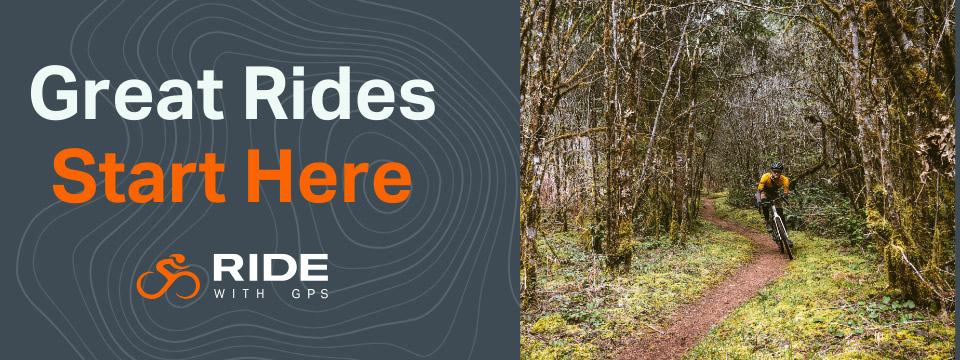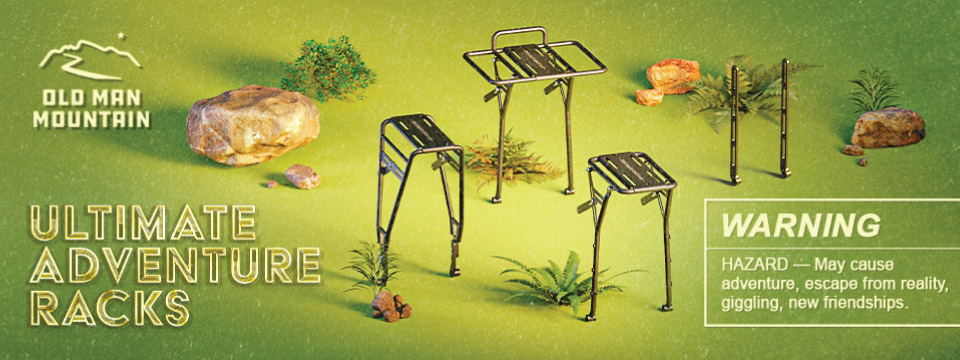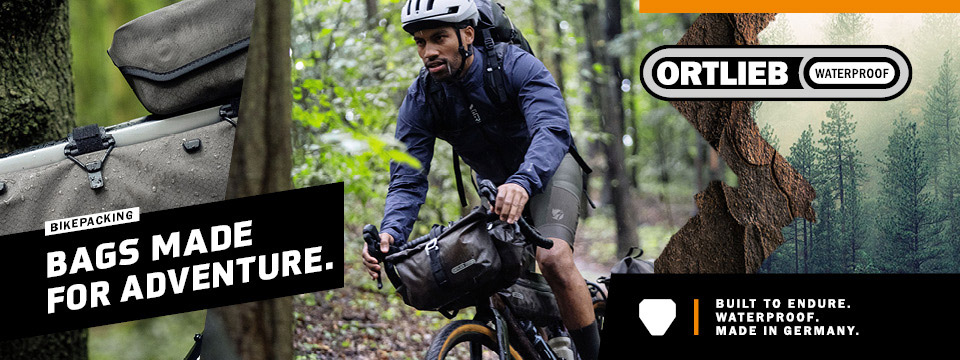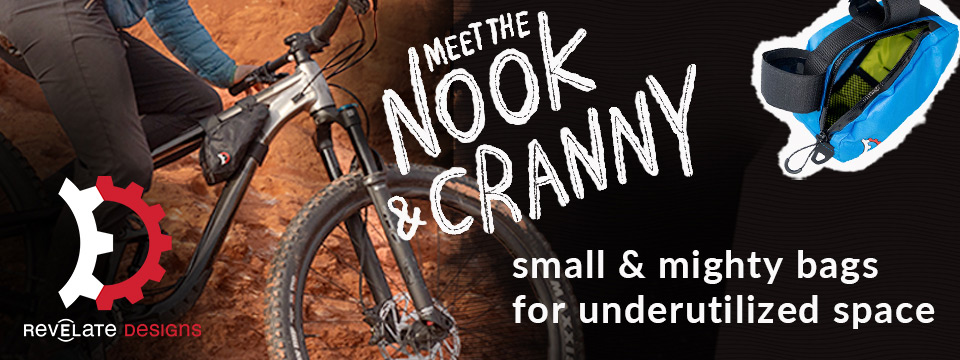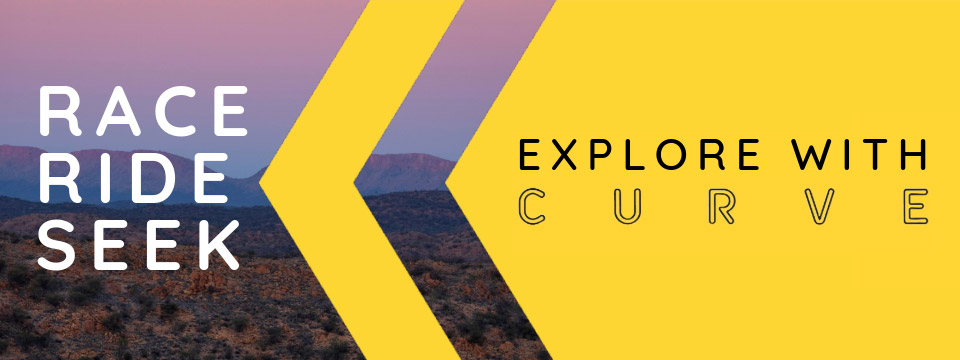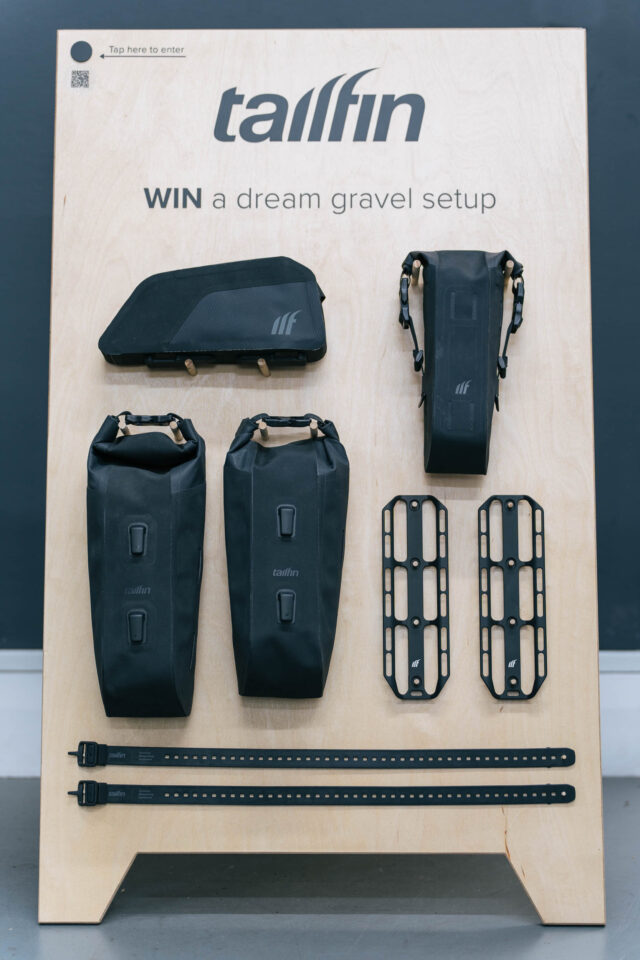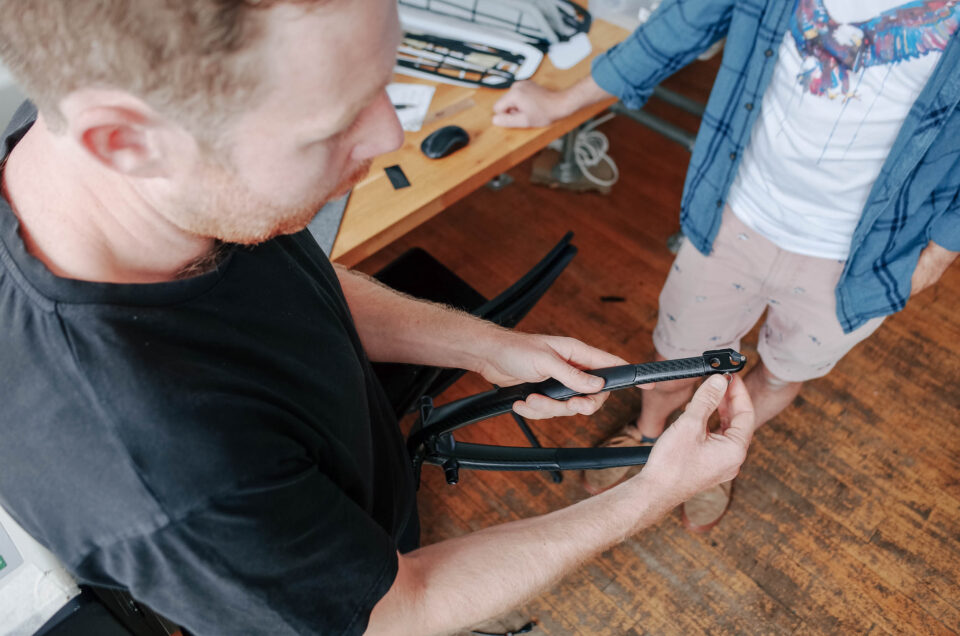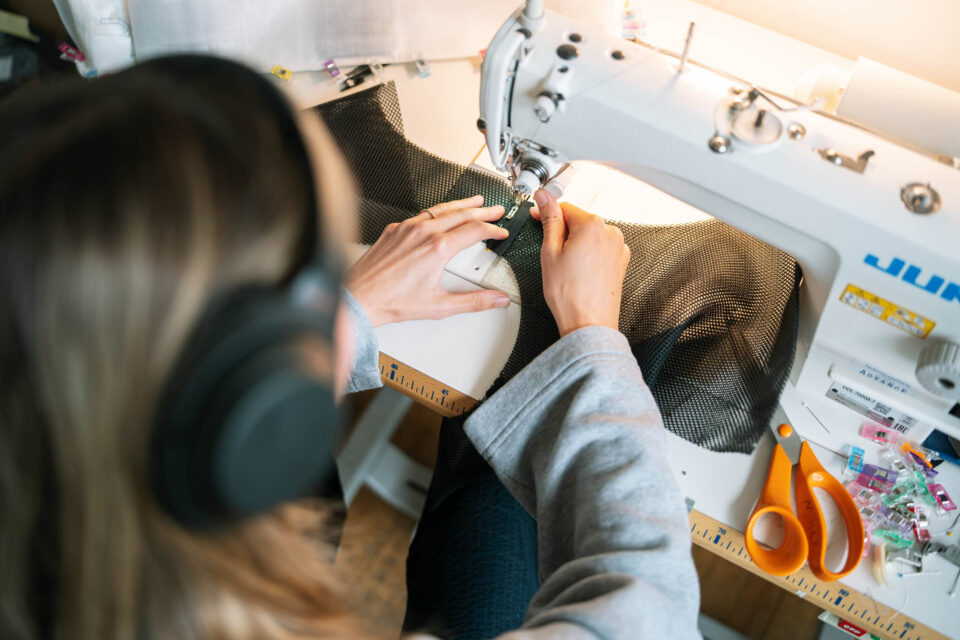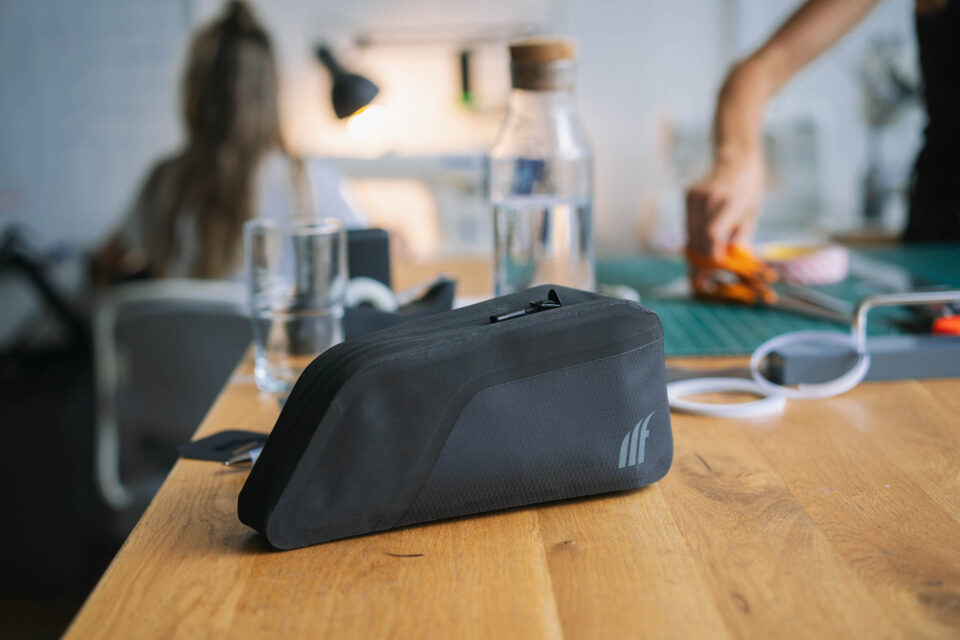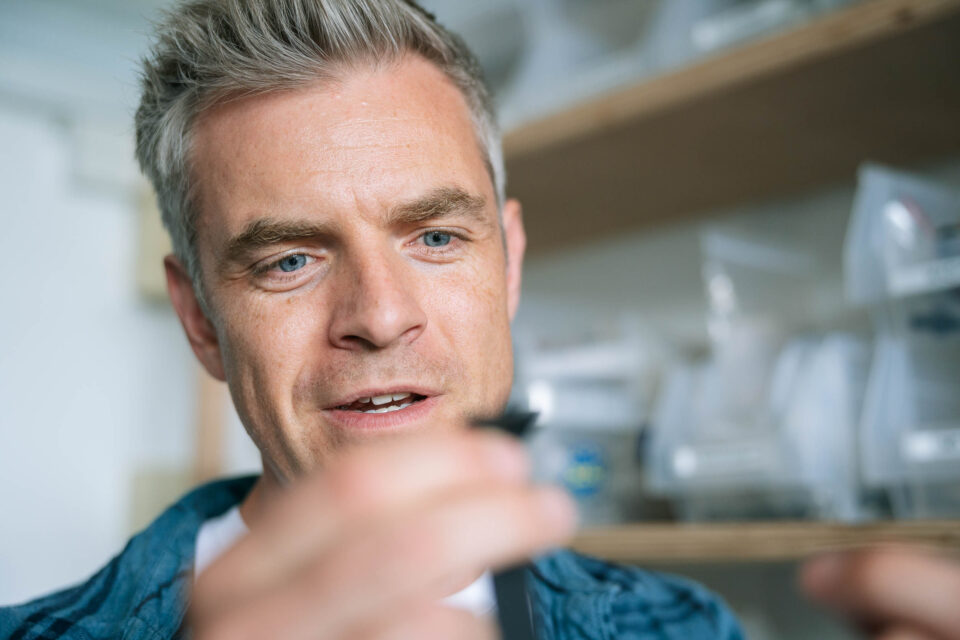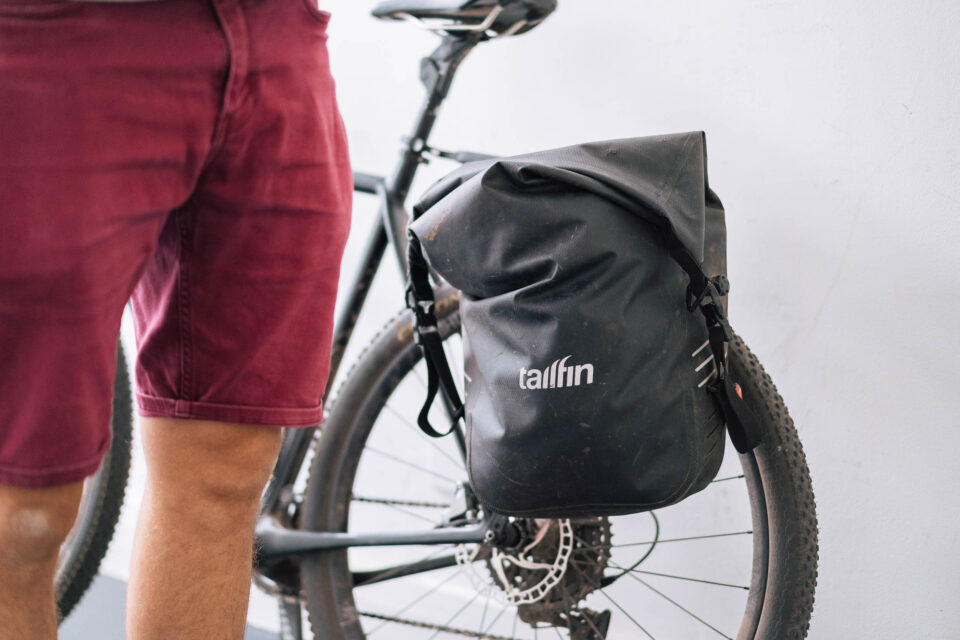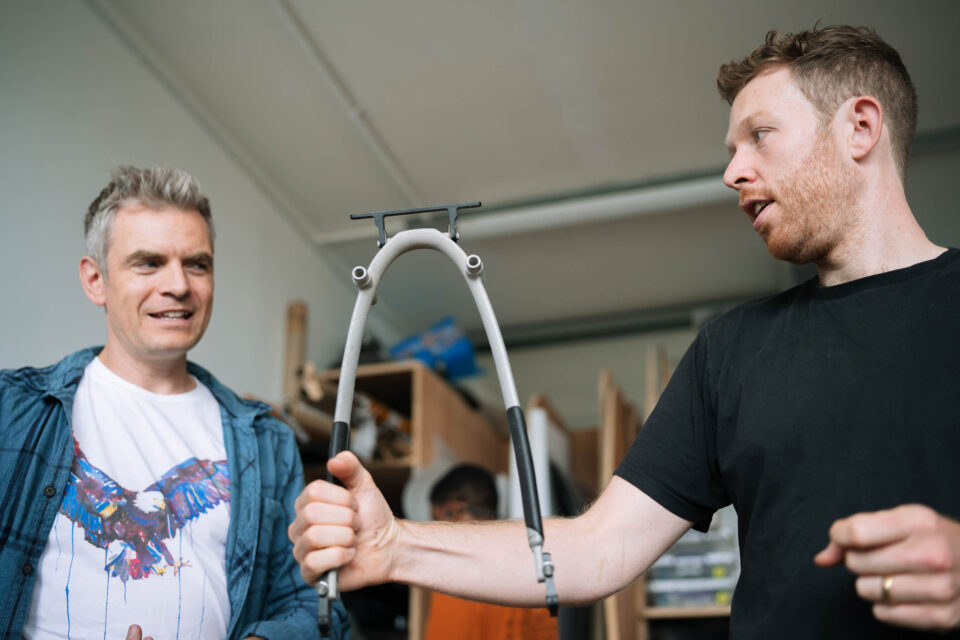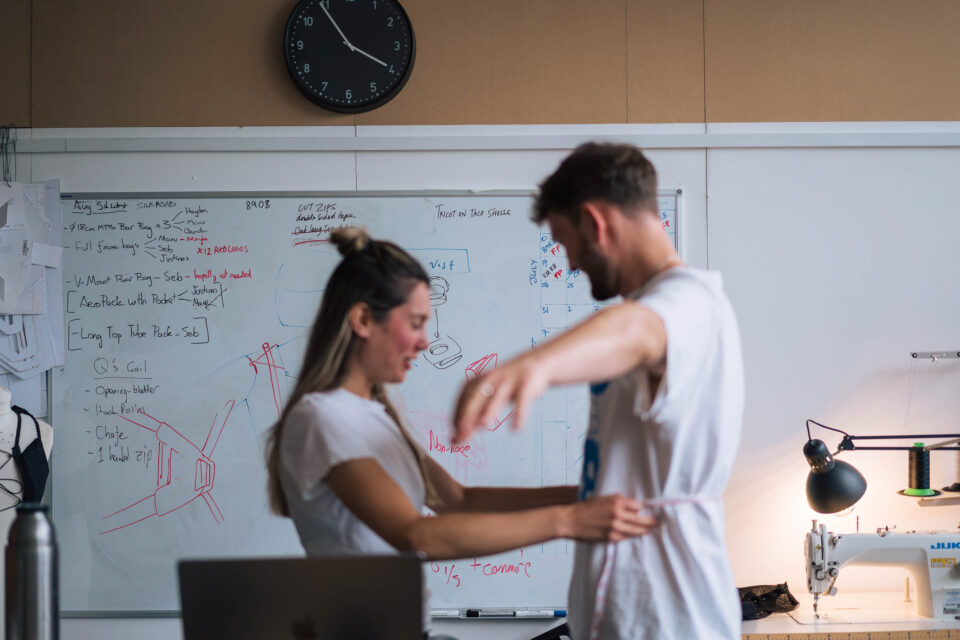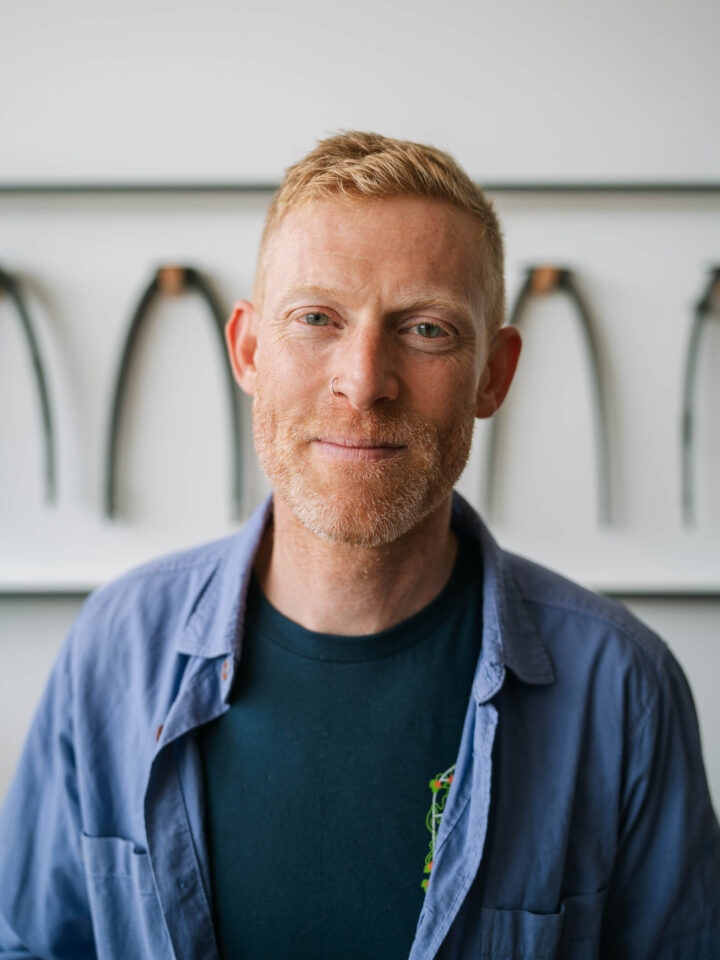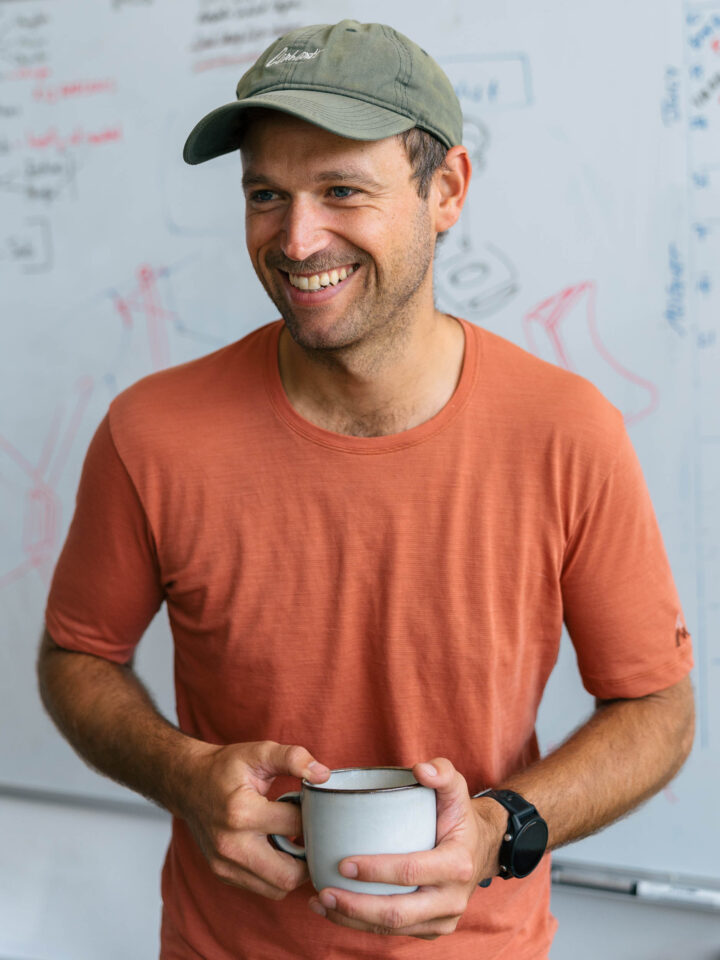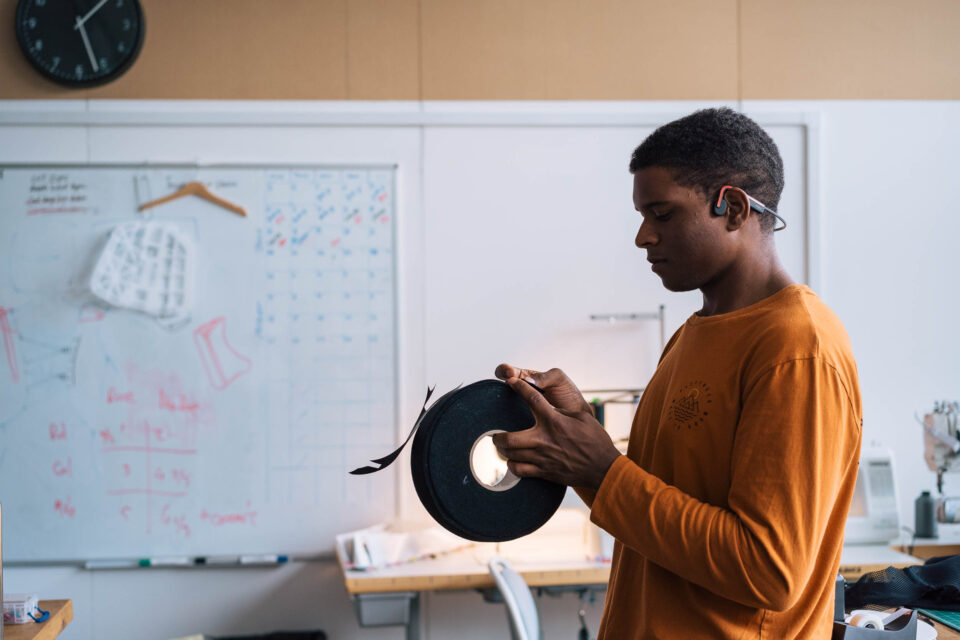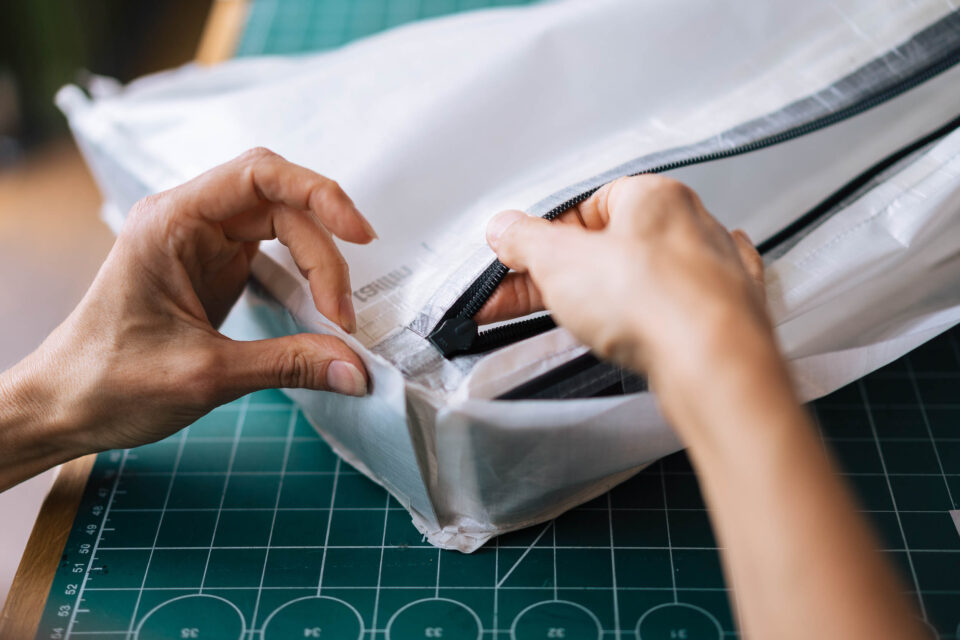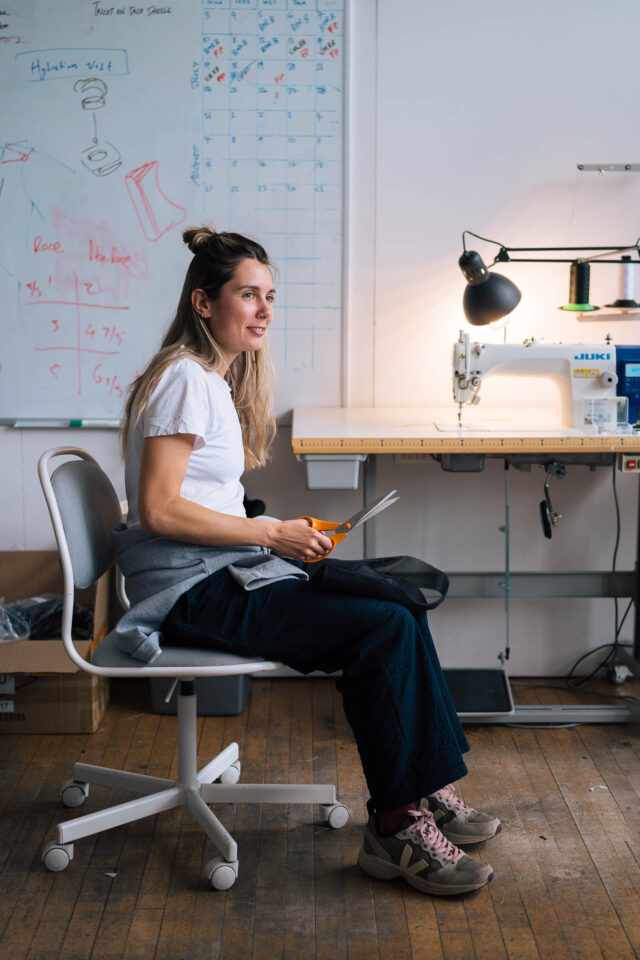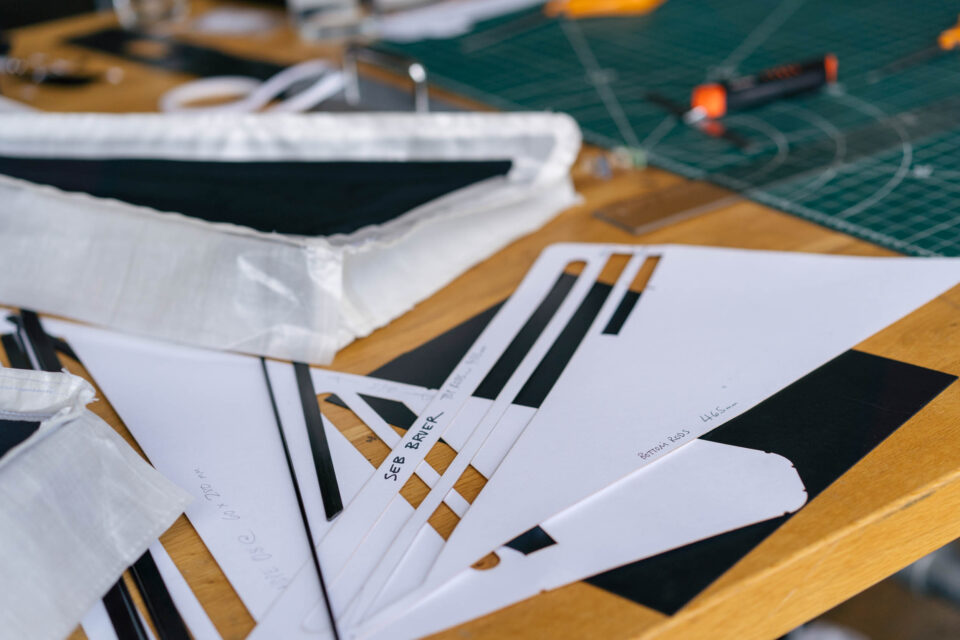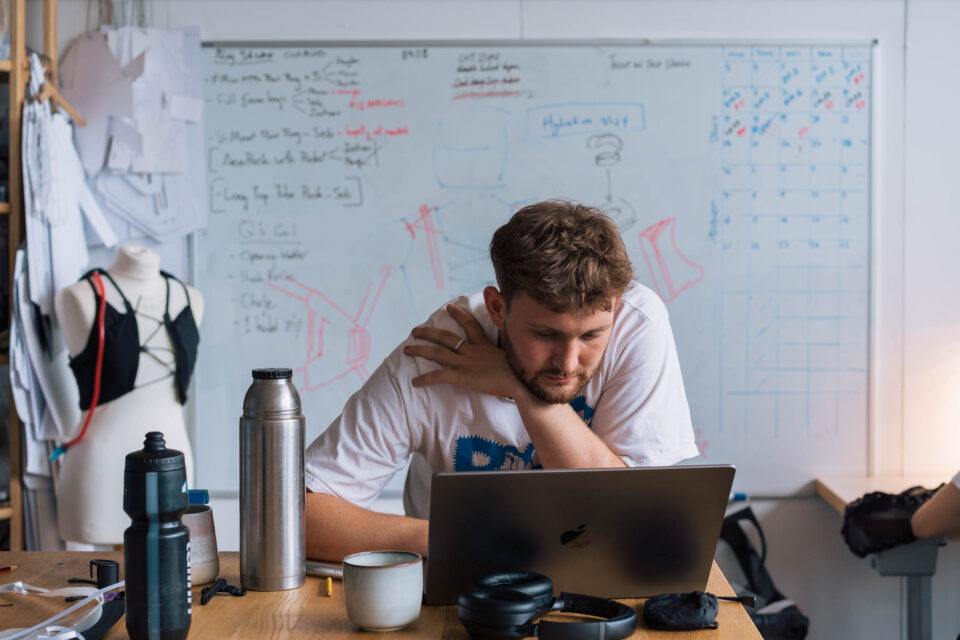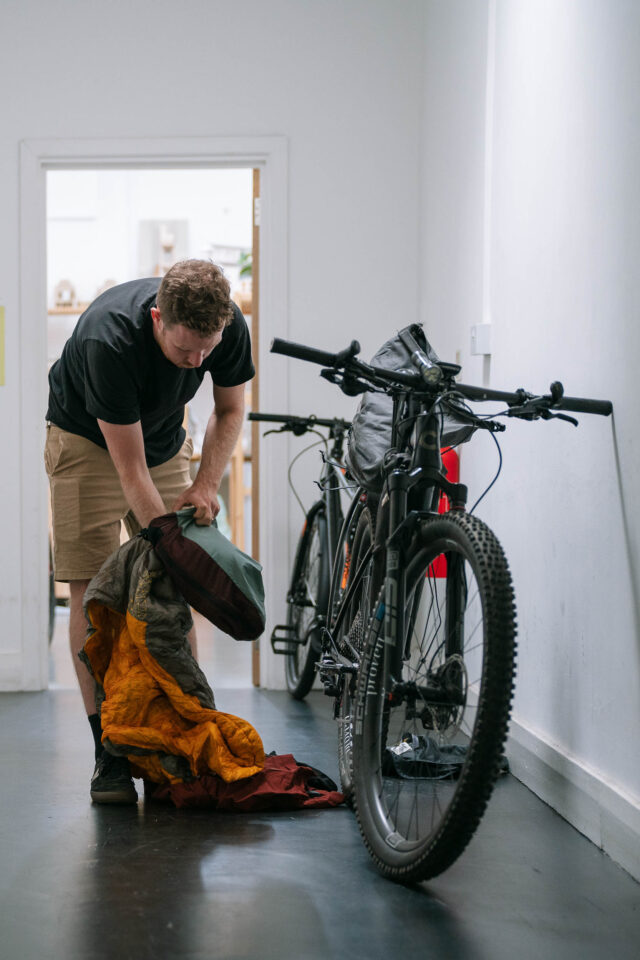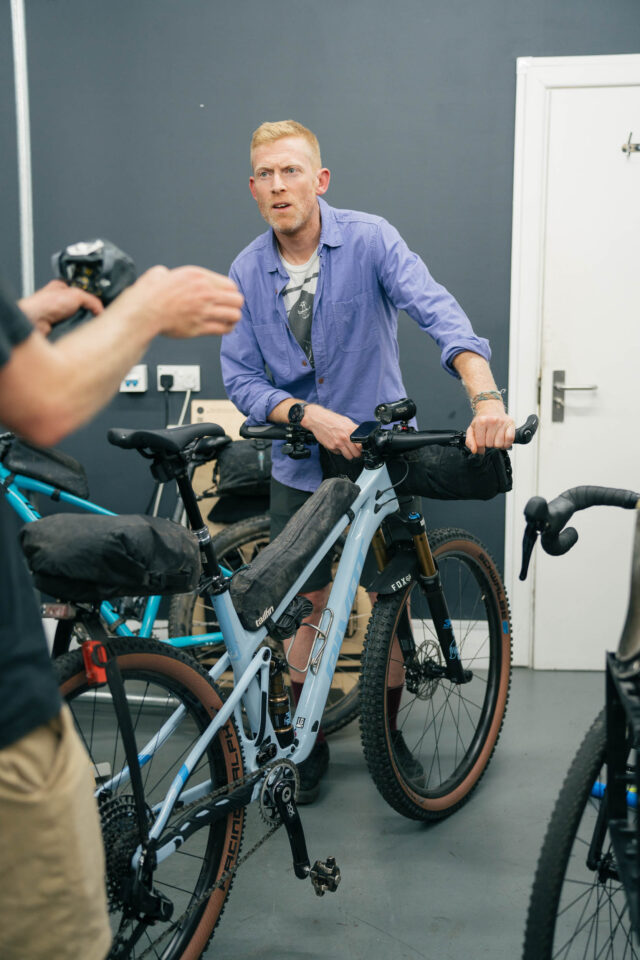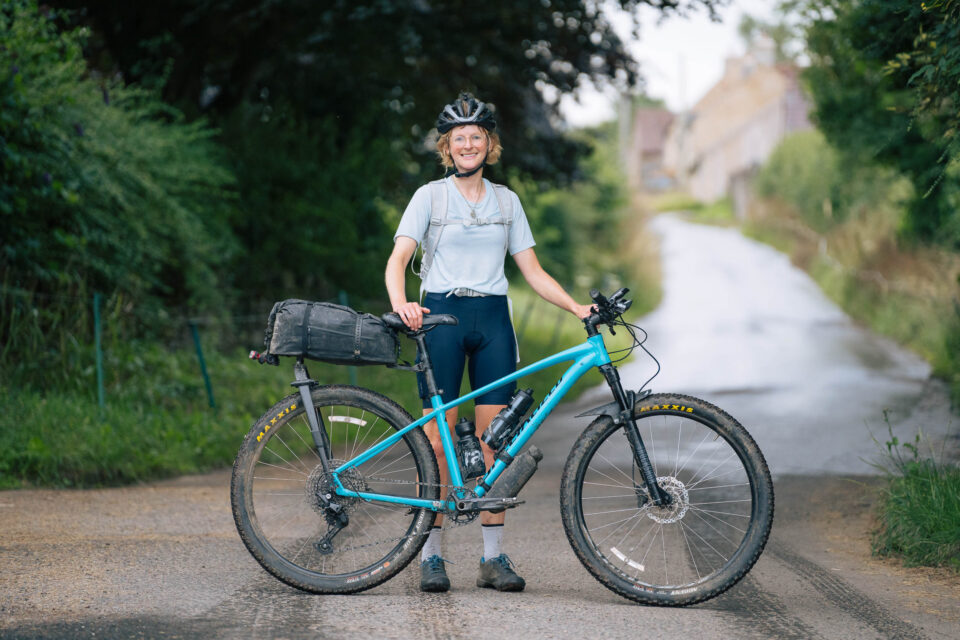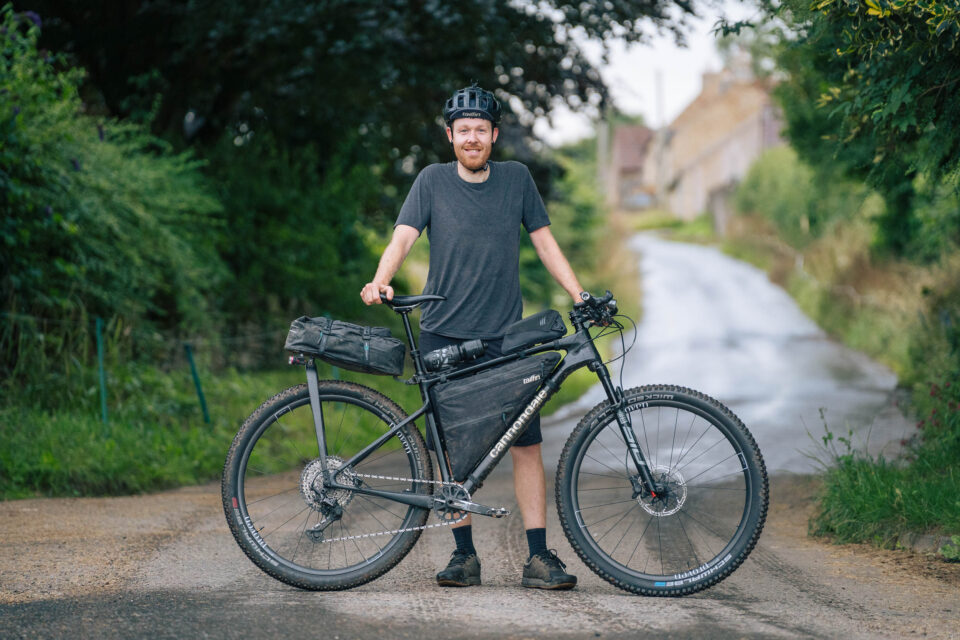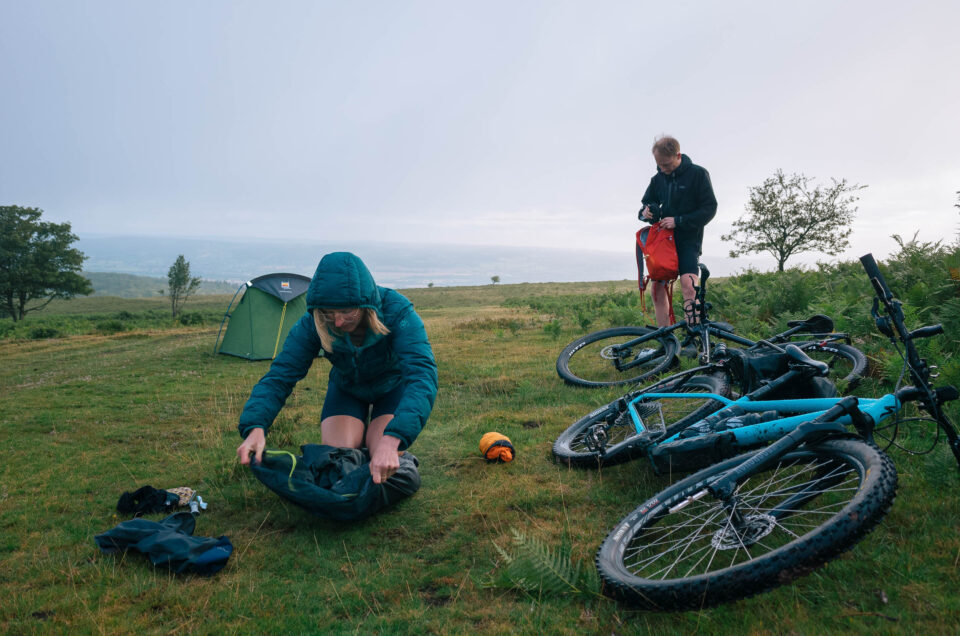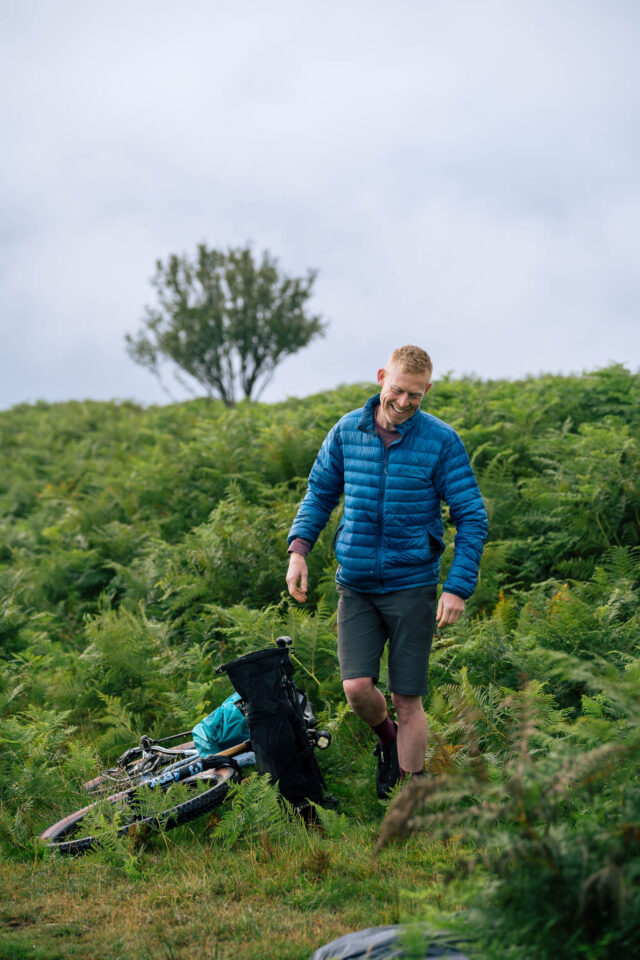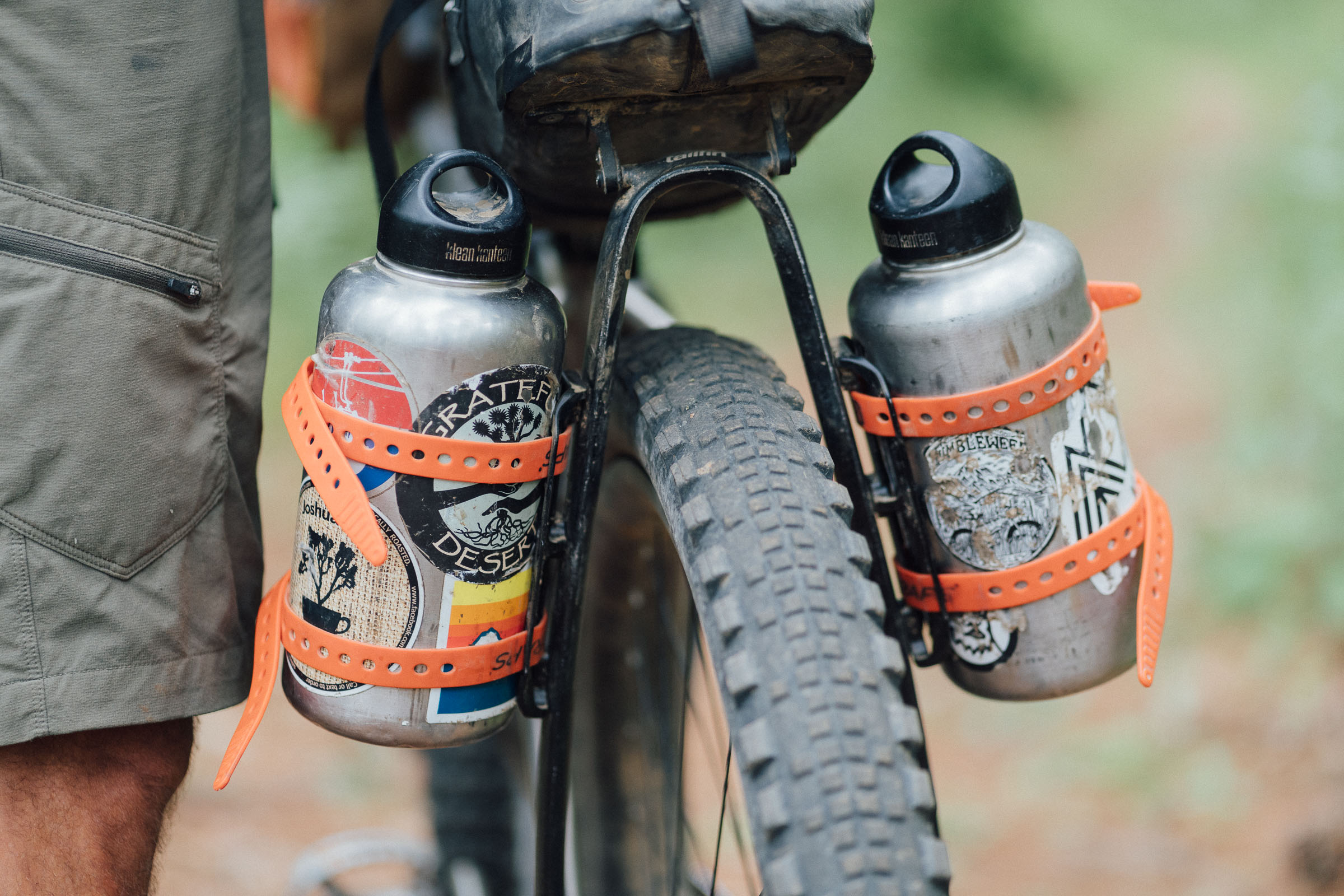Inside Tailfin: It’ll Be Okay as Long as It’s Perfect
Share This
In our latest Field Trip, Sam Rice and Bec Norman take us behind the scenes at Tailfin. Since its Kickstarter launch in 2016, Tailfin has grown from a basement passion project to one of the most innovative brands in bikepacking. Read on as Sam and Bec shed light on Tailfin’s origin story, dive deep into their product design philosophy, and reveal how their innovative fusion of hardware and soft goods sets them apart…
Co-created by Bec Norman
It’s 9 a.m., and the cafe below hums with morning orders as artists and potters and poets unite in their daily celebration of caffeine and croissants. We’re at Spike Island, a former Brooke Bond tea packing factory turned creative hub, now home to over 70 artists, designers, and creative businesses in the heart of Bristol’s harbourside. This is the headquarters of Tailfin, a space befitting a brand where art and engineering collide.
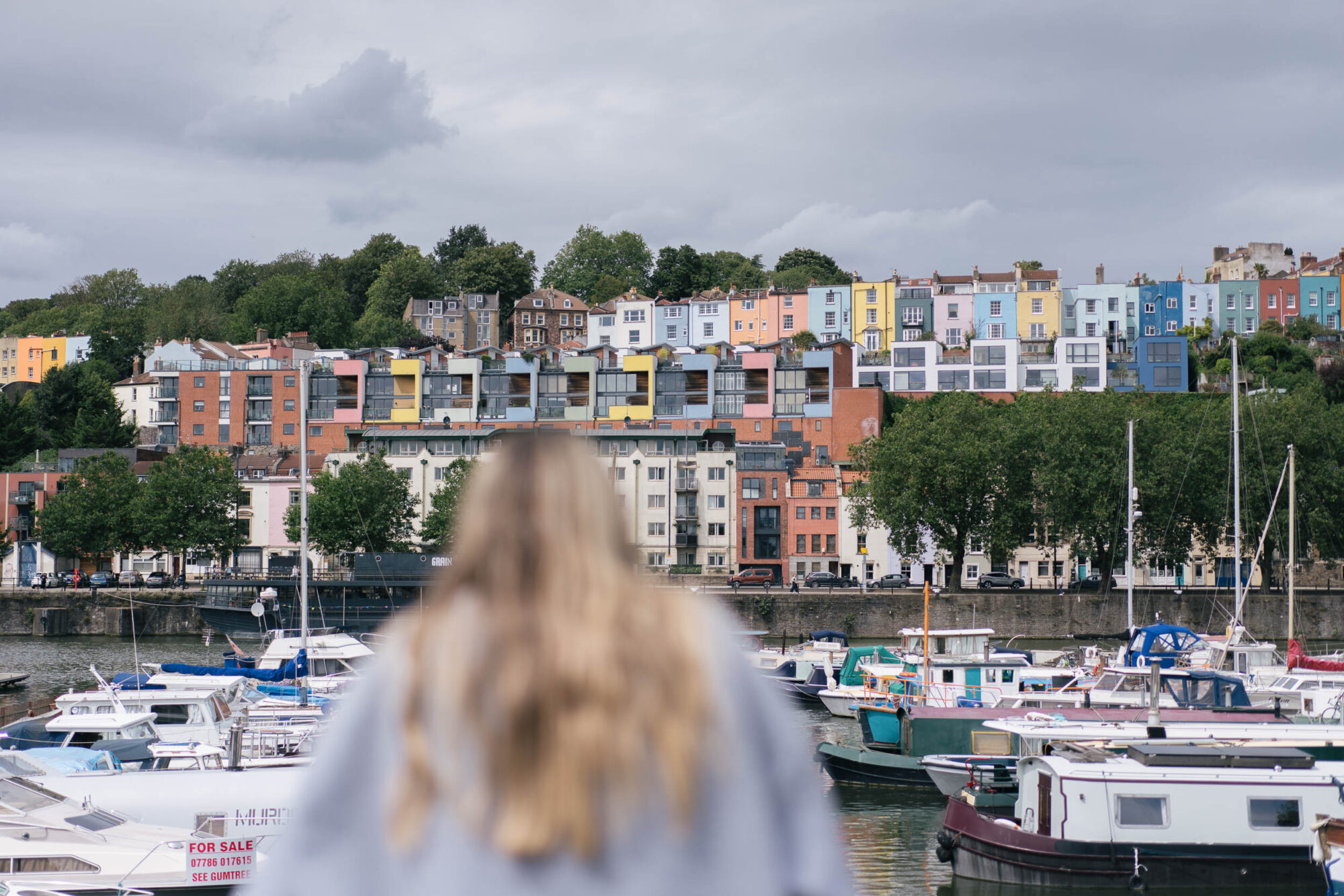
“Welcome to Tailfin, guys,” a friendly face says as the doors fly open and coffee begins to pour. It’s James Bracey (Bracey), Tailfin’s head of PR & community. “We’ve prepared a few things for you today, and the team is excited to show you a bunch of new products we’re working on. Grab your coffee, and I’ll show you around,” he says, guiding us past the various museum-scale gallery spaces and into the Tailfin R&D center.
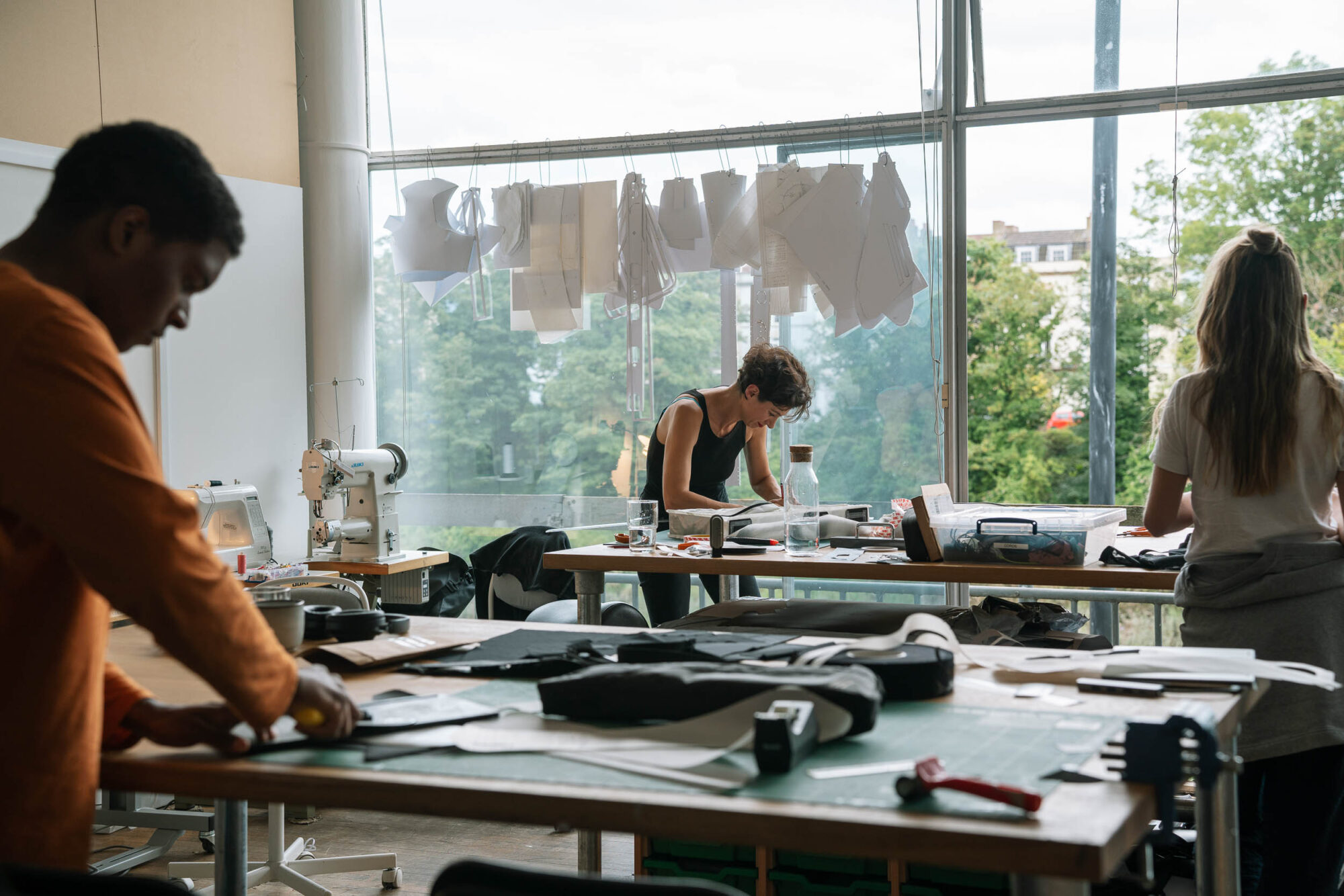
Art and Engineering Collide
The morning sun pours through the full-length windows, its warm, soft light illuminating the paper patterns hanging neatly overhead. Outside, graceful green ash trees sway in the summer breeze. A whiteboard filled with design scribbles hangs behind us, sewing machines stand sentinel, and from the back of the room, a 3D printer whines as it spits out prototype buckles ready for inspection.
“As a kid, I was utterly fascinated with the idea of being an inventor—of designing and building and bringing things to life,” shares Nick Broadbent, mechanical engineer, product designer, and founder of Tailfin. His checked shirt and dusty gray hair amplify his steel-blue eyes that flicker with excitement as he speaks. “I’d spend hours drooling over mail-order innovation catalogs, tinkering with my Tamiya RCs, and creating things with Lego,” he continues, his soft Scottish accent and warm energy filling the room.

For Nick, engineering seemed a natural path, but he hit a snag when he started researching universities in the UK. All the classical engineering degrees he read about felt too sterile and restrictive. “I was certain that I wanted to design things. But the idea of building suspension bridges and power plants didn’t really stoke my fire. I guess I was seeking a way to combine my passion for art and engineering, but I had no idea what that looked like,” he reflects, pausing to scrutinize a freshly printed buckle and jot down some notes. “Then I found product design engineering—a course that combined mechanical engineering at the University of Glasgow and product design at the Glasgow School of Art—and it was as if I’d found my calling.”
Fast-forward a few years to 2004, and Nick graduated as a product design engineer, quickly following up with an MPhil in design, manufacturing, and management at the University of Cambridge. Armed with two degrees, a boatload of new skills, and an insatiable appetite to create, he spent the next decade developing new products and technology for blue-chip clients and startups in Cambridge, UK, and Vancouver, Canada. Nick designed everything from pioneering pharmaceutical robots and medical devices to consumer technology and industrial products during this time.

The years ticked by, and life was good. Inspired by the mountain trails and wide-open gravel roads of the North Shore, Squamish, and Whistler, Nick rekindled his love for bikes. He spent weekends riding on Vancouver Island and sleeping under the stars. During the week, he commuted to the city by bike. And it’s here, while pushing the pedals, that the initial spark for Tailfin was born.
Find the problem
A keen bike commuter in Cambridge and Vancouver, Nick was all too familiar with the dreaded sweaty back syndrome caused by hauling gear in a backpack. “I had this amazing carbon road bike that I’d commute to work on. I loved everything about it—the precision of the engineering, the quality of the components. But, as modern road bikes have evolved to prioritize speed over anything else, its lack of rack mounts meant I couldn’t carry luggage.” Nick tells us as he lifts the original V1 Tailfin rack from the wall. “And on one particularly sweaty pedal to work, I remember thinking: Why can’t I attach a rack to my road bike? And why do rack manufacturers just build racks and bag makers just make bags? And why do we bolt racks that look like Dark Ages contraptions to beautiful pieces of engineering?” He shakes his head and looks down at the V1 rack still in his hand, “I had no idea what the solution would be, but I was damn clear on the problem.”
Buoyed by his rack revelations, Nick returned to the UK in 2014 and spent the next 18 months working on a solution. Then, in 2016, he launched a Kickstarter campaign for a brand new product he dubbed “The Tailfin.” Constructed from carbon fiber, “The Tailfin” was a super lightweight rack and pannier bag system loaded with clever engineering features. Its rigid, parabolic arch design offered exceptional stability, and its quick-release design enabled a truly universal fit across almost every bike.
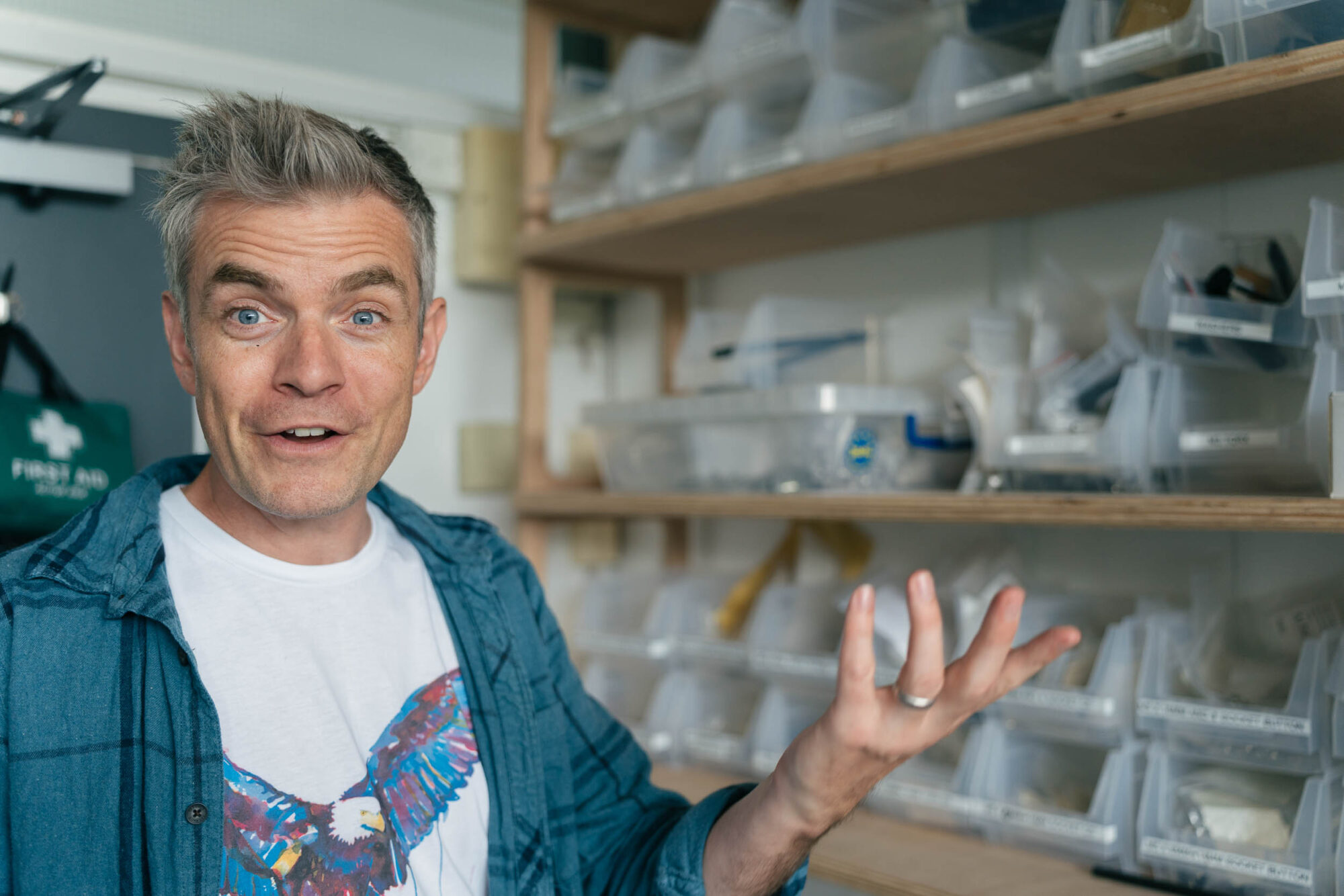
Nick hoped the campaign would raise £50,000 ($63,000) to help continue his R&D process and validate his idea. But within just weeks of its launch, it had attracted more than 700 backers, raised £157,000 ($198,000), and paved the way for Tailfin’s first leadership hire, James Atkey. A crucial character in the Tailfin story, James was brought in to run the business day-to-day and lead its transition from a cool Kickstarter campaign to the innovative brand we know today.
With one successful product in the wild and James onboard to help drive growth, Nick’s mind began whirring with new ideas. “We’d already done the hard work in finding the right manufacturing partners, developing a rock solid rack, and perfecting the RF welded fabrics.” Nick explains, “So I started looking at ways we could use Tailfin technology and innovation to help solve the other frustrations people had with bags.” He didn’t need to look too hard to find bikepacking’s most notorious offender: the seatpack, which is plagued with problems, from swaying and sagging to dropper-post compatibility and quick access to contents.
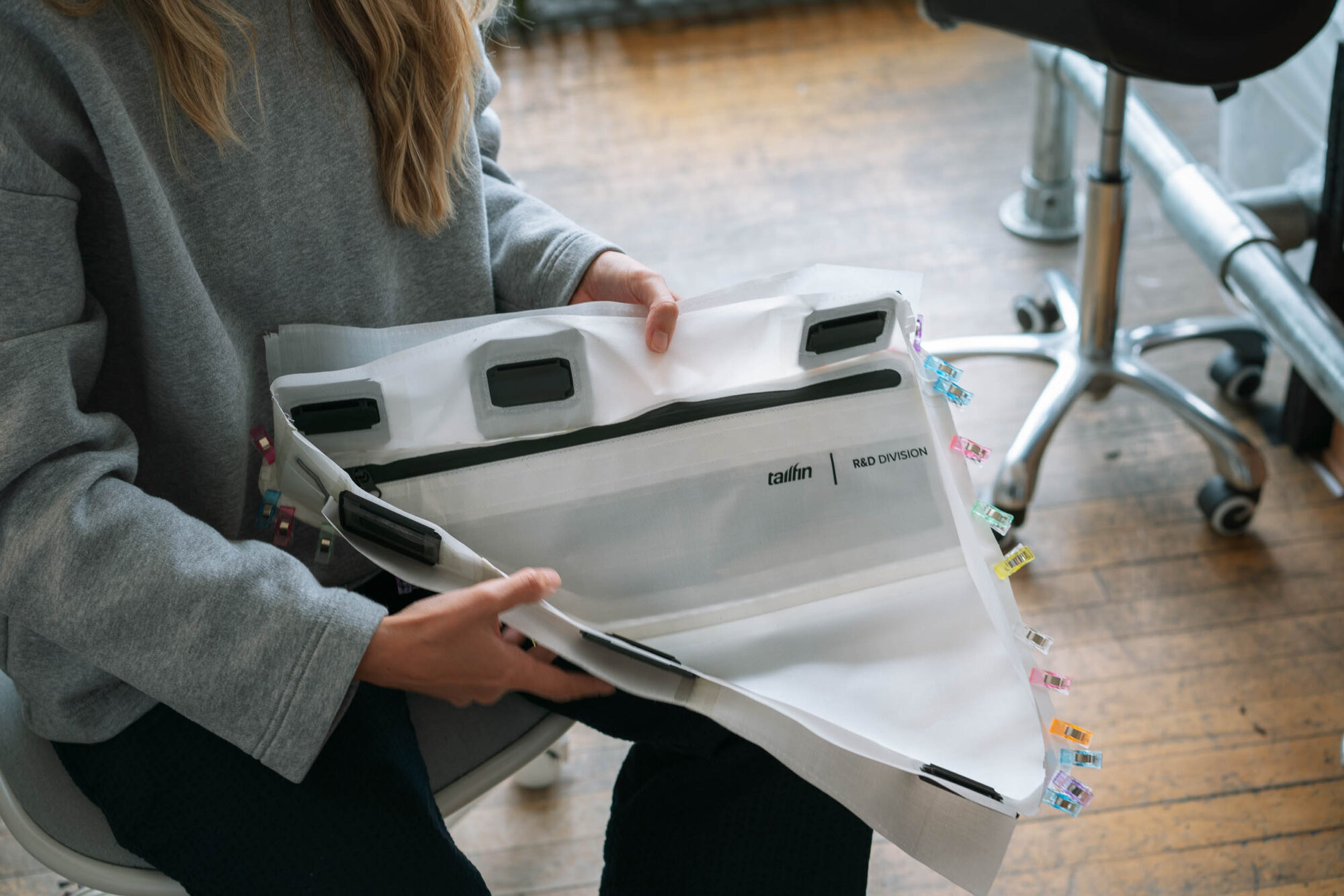
Nick got to work, and in 2018, he launched the AeroPack. A cross between a racktop bag and a modern seatpack, the AeroPack features a top-loading, waterproof roll-top bag permanently fixed to the same lightweight carbon (or alloy) rack featured in Tailfin’s original offering. Jam-packed with all the engineering detail and ease-of-use considerations we’ve now come to expect from the brand, the AeroPack is an extremely stable system that strikes a perfect balance of weight, space, and usability. It’s less restrictive than a seatpack but more minimal than a set of bulky panniers. “We took the best parts of seat packs and pannier bags and combined them to create the ultimate way to carry gear on a bike,” Nick says as he passes me a new Aeropack prototype and explains its features.
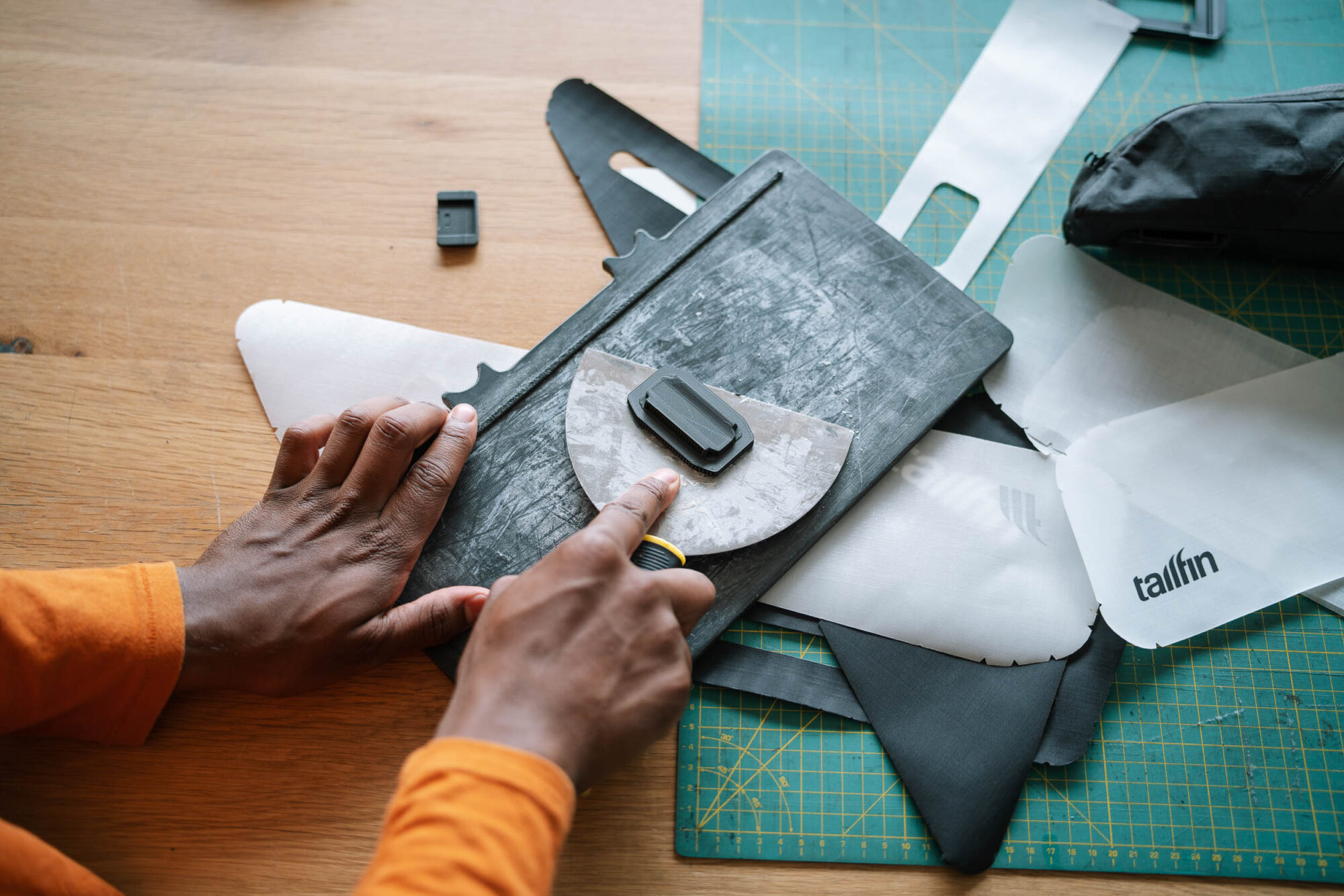
By 2019, the AeroPack could be seen across the bikepacking world: from ultra-endurance racers like Josh Ibbet and Jay Petervary to bike tourers and route builders like Andy Cox and Vedangi Kulkarni. Its unique design initially split the pack. Was it a product for bike tourers? Gravel racers? Mountain bikers? It challenged the community to think outside of the industry nomenclature and arbitrary labels of who a product is for, irrespective of riding style. And in so doing, Tailfin aimed to create a product that was for everybody.
Hybrid Thinking
In a corner of the room, Rob and Nick are deep in the problemverse, sparring with a new idea. They wrestle in turns as ideas ricochet off the walls and back to them in the kind of joint conversation where friends fill in the missing pieces of each other’s ideas. Rob Phillips, Tailfin’s head of brand and design, is a Swiss Army knife of design skills. A highly experienced industrial designer and talented product designer, Rob complements Nick perfectly. “Today, we’ll walk you through our prototyping process from start to finish,” Rob explains as he and Nick take a breather. “And by the end of the day, you should leave with a brand new top tube pack,” he adds, introducing us to Liv Cowley, Tailfin’s head of soft goods, and Molly Lewis-Smith, their lead prototyper.
Surrounded by half-built bags, streams of 3M tape, and a Lego box of printed parts, Molly is an oasis of calm. Dressed all in black, her bright red lipstick and infectious smile light up the room. “Ever used a laser cutter before?” she asks as we shake our heads nervously. “Couldn’t be easier! Let’s just put the finishing touches to this frame bag for Seb Breuer, and we’ll get on to building your new bag, alright?”
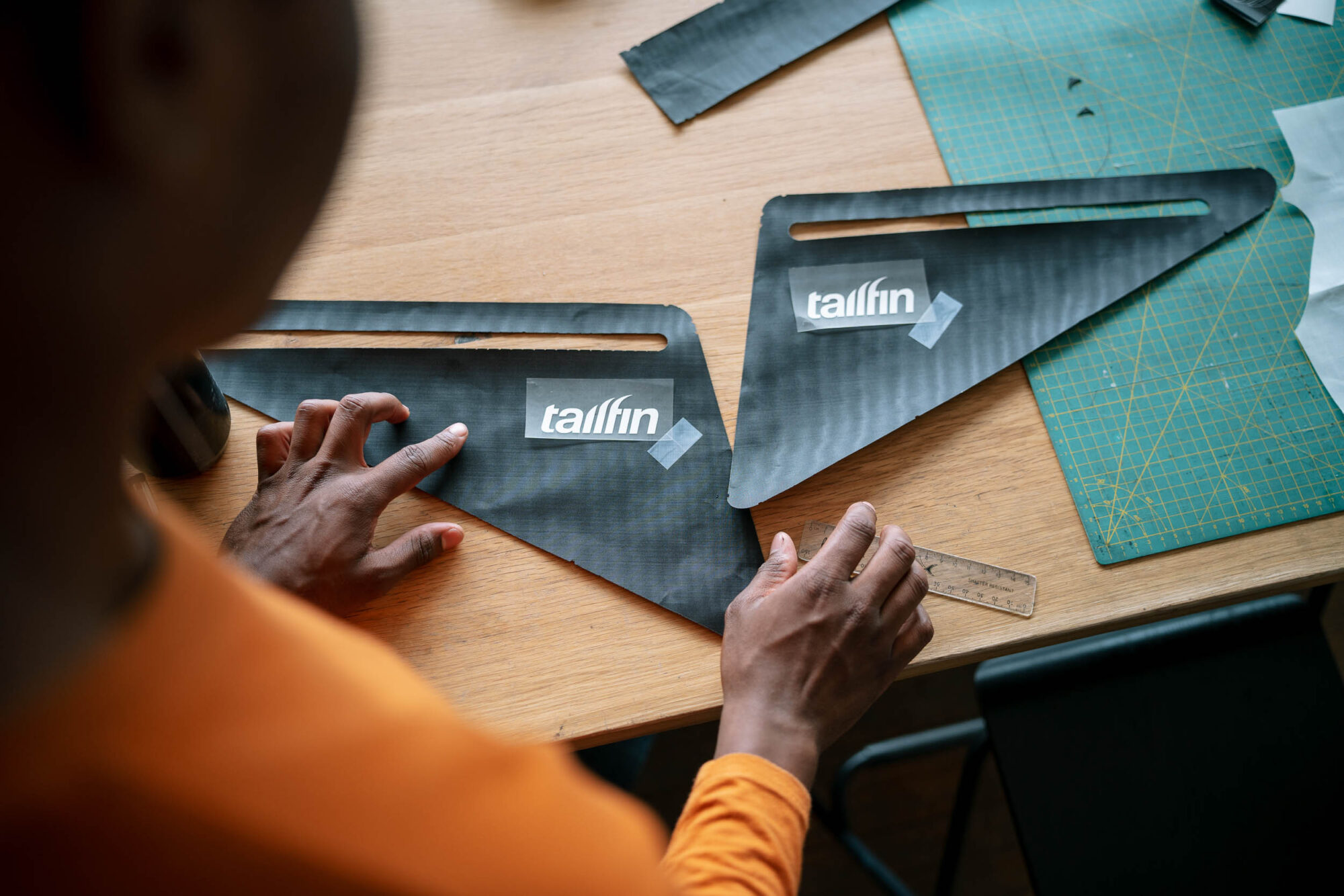
Our visit falls a couple of weeks before the Silk Road Mountain Race (SRMR), an ultra-endurance event many of Tailfin’s R&D Division riders compete in yearly, so the team is flat out. Custom frame bags built from Dyneema, prototype handlebar bags, and new AeroPack features are all being researched, designed, and prototyped right here in Bristol. However, instead of the usual chaos that accompanies race prep, the studio feels grounded and organized. Watching the teamwork feels like observing a ballet troupe perform. Liv is designing a new pattern for Tailfin’s first wearable product, while Rob and Nick are busy finalizing new features for the next AeroPack. Perfectly in sync, they all dance around the space, moving from one station to another, oscillating from measuring and cutting to sewing and stitching as prototype packs come to life before our eyes.
“All of the products we design start right here in our product development space,” Rob explains as Molly begins working on our pack, feeding fabric into the laser cutter. “As a team of designers, we all bring different specialisms to the mix. Whether it’s designing our proprietary hardware, utilizing the best industrial design and manufacturing techniques, or crafting the welded, waterproof bags themselves, we cover the full product design spectrum to create the best products possible for riders.” It’s a sentiment echoed by the fact that the team themselves are mountain bikers, cross racers, fixie riders, commuters, bikepackers, and roadies. So, creating these products is as much about scratching their own itch as it is about scratching yours or mine.

The laser cutter hums to a halt as Molly reaches inside and removes the perfectly cut pieces of fabric. “Ever since the first V1 rack, we’ve been committed to this hybrid approach to hardware and softgoods,” Liv says. “And from a design perspective, it makes complete sense to us. Rather than designing in isolation, we integrate both design practices under one roof, which enables us to prototype, test, receive feedback, and refine ideas in real-time as one collaborative team.”
Across the room, Nick’s ears prick up. He’s caught wind of our conversation, and within seconds, he’s at the table, eager to join the chat. “Take the top tube bag we’re building you guys, for example,” Liv says as we watch Molly lay down the first stitches in the outer fabric. “Without the integration of our 3D-printed hard shell to give it stability and our V-Mount system to attach it to the bike, it would just be another top tube bag,” she explains, baiting Nick as he picks up her thought and runs with it. “And likewise, without our softgoods team being able to show us how each micro-adjustment or slight angle alteration affected the final bag design, we’d still be printing different hard shell thicknesses and going around in circles,” Nick adds as the whole team laughs. It’s here, at the confluence of soft goods and hard goods, that Tailfin products thrive.
The Future Of Design At Tailfin
In the early days of Tailfin, everything orbited around Nick. He served as the lead product designer, manufacturing expert, marketing lead, sales guy, and mechanical engineer. He was the driving force behind every product that wore a Tailfin logo and won an ultra-race. Nowadays, though, he’s no longer alone. Tailfin is now home to 15 of the industry’s best designers, marketers, and operations specialists. They partner with specialist manufacturers in China, Vietnam, and Taiwan, collaborate with the best creative minds in the world, and gain real-world feedback and support from a global team of R&D riders. Today, the true strength of the business no longer rests on one person’s shoulders. It’s drawn from the entire team. The people behind the products. The humans behind the brand.

“The launch of our top tube pack was an immensely proud moment in the history of the company for me,” Nick shares as he glances around the room at his busy team. “Because, unlike the original Tailfin products that were solely designed by me, the top tube packs were the first range that combined the skills of our complete product development team,” he continues. “Everyone played a significant role in their creation: Rob helped create the V-Mount system that has since become a mainstay in our product lineup, featuring in both our downtube and top tube packs. Liv worked tirelessly to ensure the final pack’s shape was perfectly tapered to avoid knee rub, and our R&D riders put the pack through hell in real-riding conditions. Without the whole team and the opportunity to bounce ideas off of each other in this way, we simply wouldn’t have achieved such a great end product.”
The room around us swells with creative energy. Molly is putting the final touches to our prototype pack, meticulously hand-stitching the V-Mounts in place before taping up the seams to make it waterproof. Across the room, Rob and Liv delve deep into a new product idea, ironing out the details and charting a path forward. Concepts flow freely as new ideas leap from scribbles on a notepad to paper prototypes in minutes. Liv begins drafting a sample pattern, keen to understand how the puzzle might fit together, while Rob sifts through his treasure chest of prototype buckles, belts, and clips. We’re witnessing Tailfin’s rapid prototyping process in real time. Bec looks over to me, I can tell she’s thinking the same thing: This is the future of Tailfin.
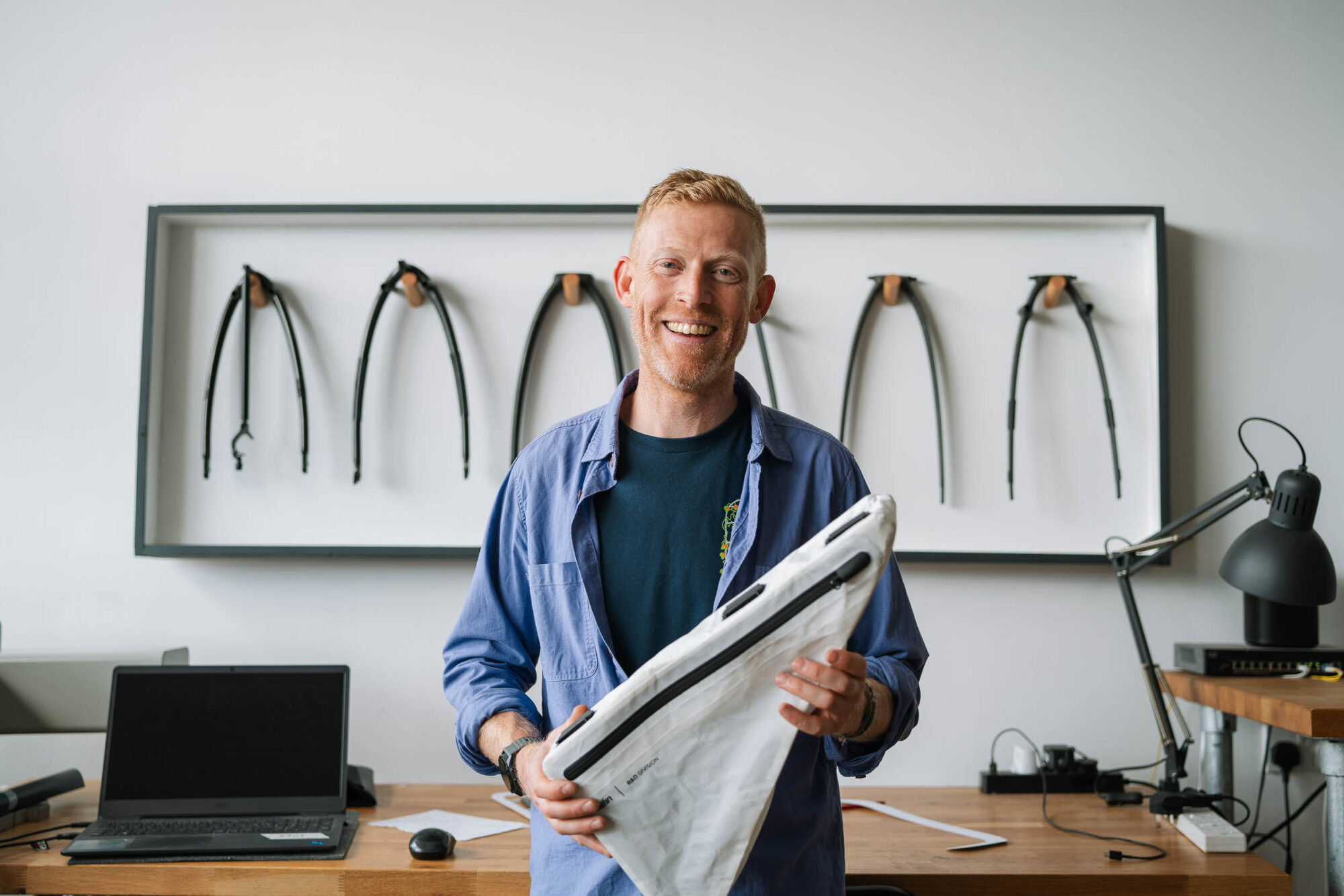
“I firmly believe that the best way to unleash people’s creativity is through intrinsic motivation,” Nick tells us as the sun cools and the room quiets. Liv, Rob, and the rest of the team have stepped next door to pack for the overnighter we’re heading out on, and for the first time all day, we’re alone in the R&D space with Nick. “Ultimately, our goal is to build the best products on the market. And in my experience, when designers work on projects that truly interest them and are given the space, trust, and opportunity to make the things they love, the result is a product everyone can be proud of,” Nick says as he shuffles through his notes and switches off the 3D printer.
“See you at the pub, guys!” Bracey shouts as he walks past the room, the sound of his freehub whirling down the corridor. We’re all heading out for the quintessential English evening: a bike ride in the rain followed by a cozy pub dinner and a soggy bivvy under the stars. What more could we ask for? “We’ll be sleeping up on the Mendips tonight,” Bracey tells us. “The forecast is looking dry as a bone. But just in case, I’d consider bringing a shell,” he says with a mischievous look as the team drags their bikes outside and begins the ride. Bike computers bleep, and safety bananas get strapped to frames. We fire off the final pre-mud shots and prepare for an adventure with the whole team. It’s the perfect way to wrap up our visit.
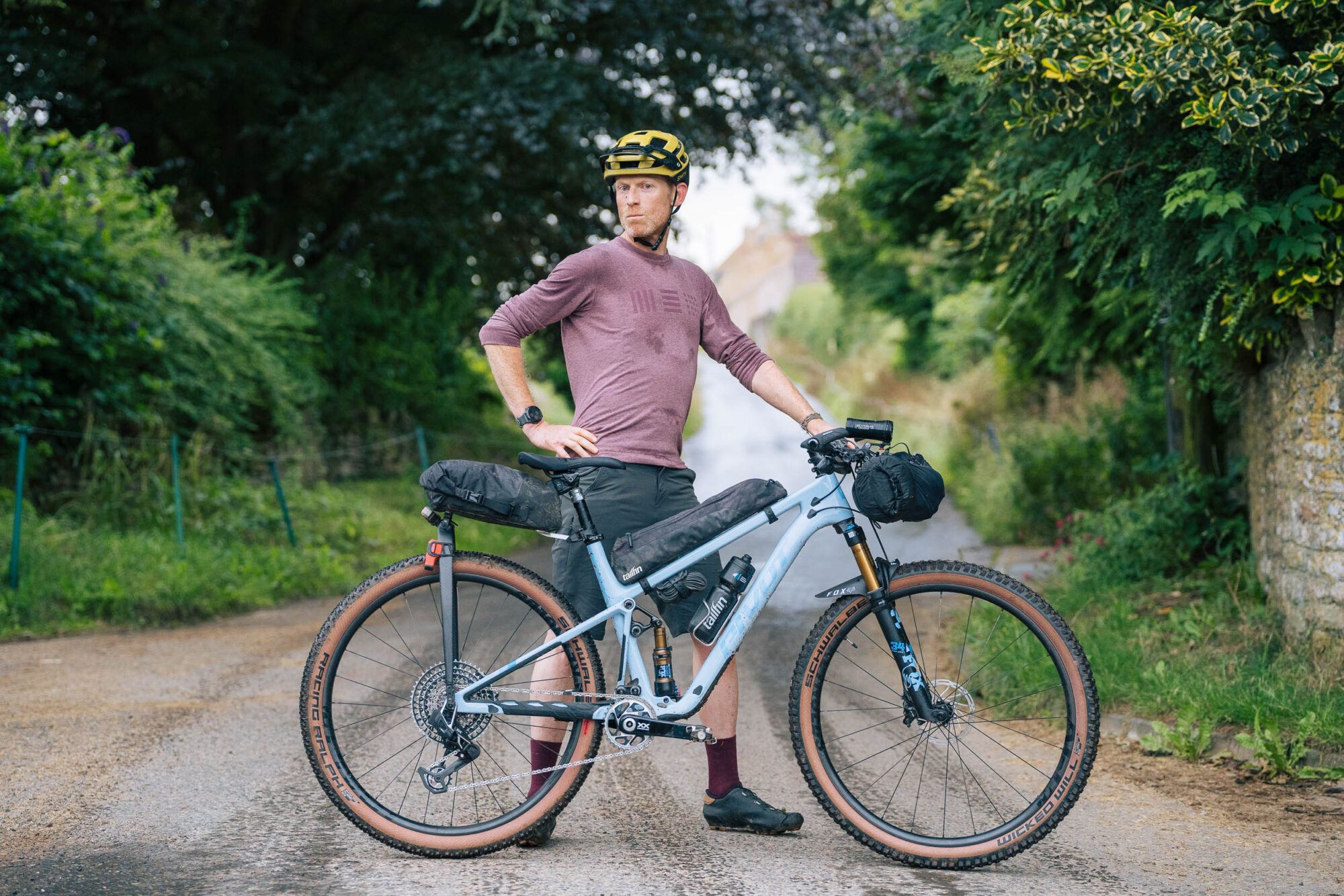
A Field Trip to Remember
Over the years, Bec and I have been fortunate enough to visit multiple makers around the world. However, we’ve never experienced anything quite like Tailfin. The level of engineering detail, precision, and accuracy that Tailfin imbues into each product is mind-blowing. Every millimeter is meticulously considered, and every gram is evaluated because “good enough” simply isn’t acceptable at Tailfin.
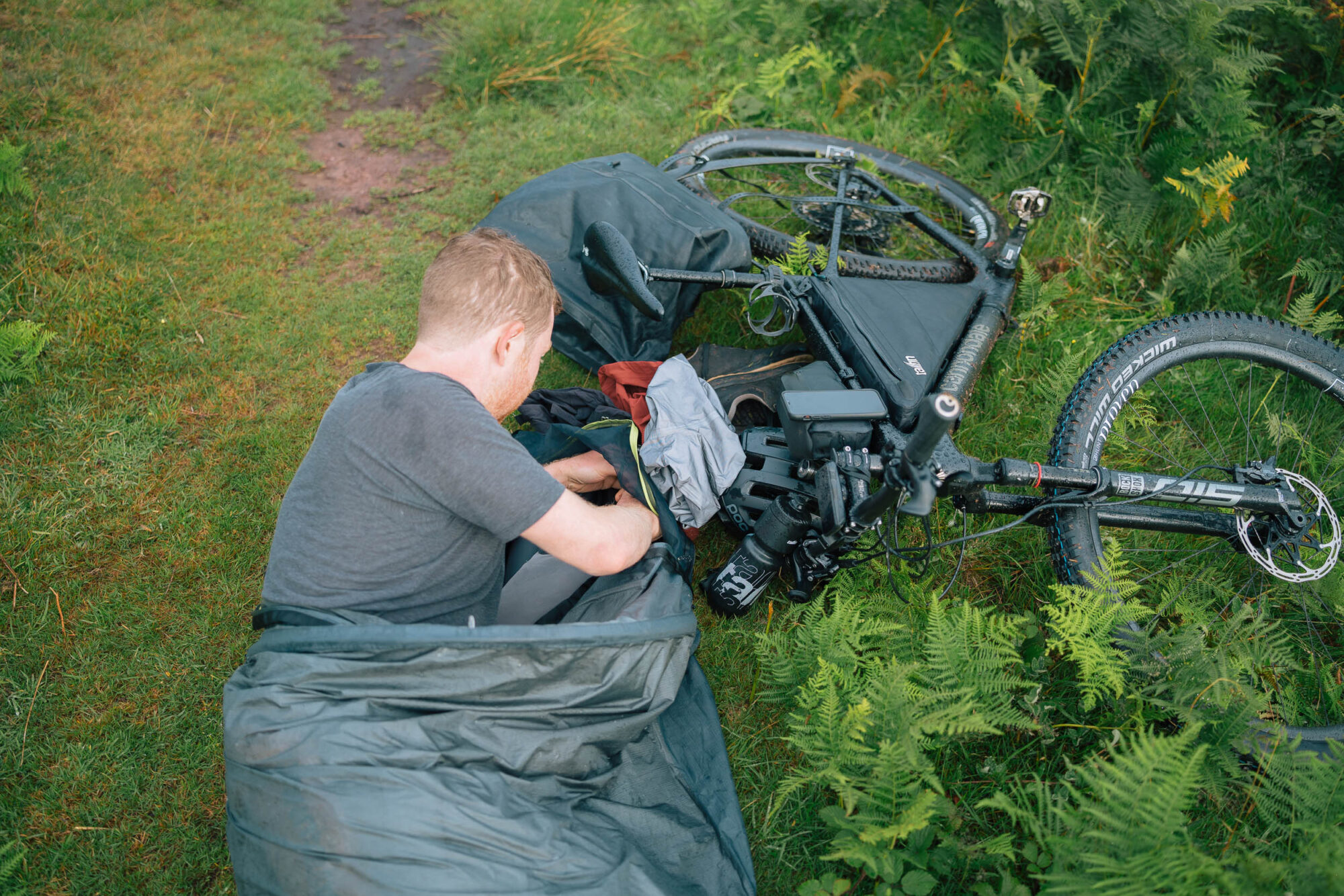
This unwavering determination to produce the best product possible propels the team forward. A slight bit of rubbing, a tiny hint of play, or a touch too much resistance on a zipper, and a product doesn’t make the cut. No excuses. No remorse. At first glance, it may seem pedantic, even obsessive, but as bikepackers, riders, and racers themselves, they understand the importance of every last detail, no matter how small.
“We have a saying at Tailfin,” Nick explains, “It’ll be okay as long as it’s perfect.” And it’s a sentiment they truly live by.
Learn more about Tailfin and explore their full range of products over at Tailfin.cc.
Further Reading
Make sure to dig into these related articles for more info...
Please keep the conversation civil, constructive, and inclusive, or your comment will be removed.







